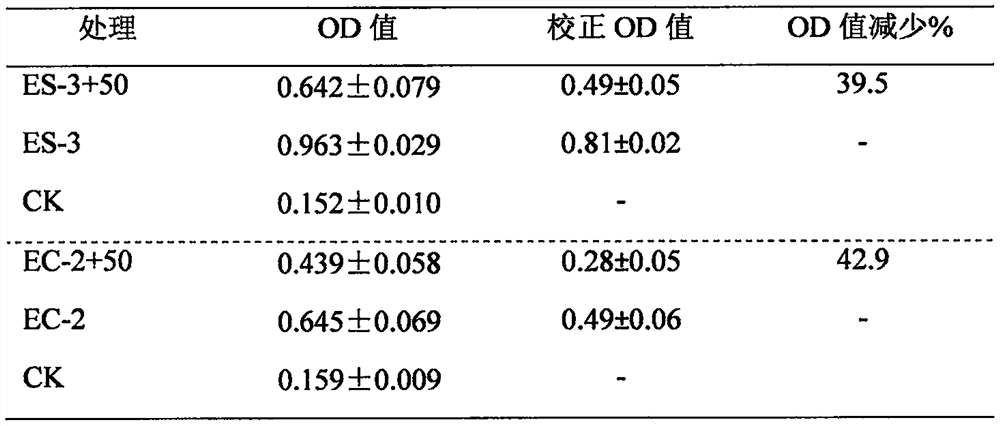A Coptidis endophytic bacterium that inhibits intestinal conditional pathogenic bacteria attached to fresh vegetables and its application
A technology for pathogenic bacteria and intestinal diseases, applied in the direction of bacteria, antibacterial drugs, and methods based on microorganisms, can solve the problems of limited resources of traditional Chinese medicine, and achieve the effect of simple use, easy production and preservation, and storage resistance
- Summary
- Abstract
- Description
- Claims
- Application Information
AI Technical Summary
Problems solved by technology
Method used
Image
Examples
specific Embodiment 1
[0021]Specific example 1: paper plate method to measure the inhibitory effect of Coptis chinensis endophytic bacteria HL-2-7 strain on Escherichia coli
[0022] Transfer Escherichia coli and HL-2-7 strains to 5mL beef extract peptone liquid culture solution in a 15mL centrifuge tube, culture at 30°C, 180 rpm for 12-18 hours with shaking, take it out, and store it in a refrigerator at 4°C for later use . Count on the hemocytometer plate, adjust the concentration of Escherichia coli suspension to 10 8 / mL. Take 100 μL of E. coli culture solution, add it to the beef extract peptone medium plate, spread it, and let it dry. Aseptically clamp three pieces of sterilized filter paper and put them into the suspension of endophytic bacteria to be tested, dip in the suspension of bacteria, take it out, dry it slightly, and stick it on the flat plate coated with pathogenic bacteria. Three replicates of Petri dishes were made, and the control was a piece of filter paper not inoculated w...
specific Embodiment 2
[0024] Specific example 2: Inhibition of endophytic bacteria HL-2-7 aseptic fermentation filtrate of Coptidis Rhizoma on intestinal pathogenic bacteria
[0025] First, 100 μL of the suspension of Escherichia coli EC-2, Enterococcus faecalis ES-3 and vancomycin-resistant enterococcus VRE (10 8 / mL) was spread on the MHA medium, then the Oxford cup was placed on the medium, and 200 μL of the sterile fermentation filtrate of endophytic bacteria HL-2-7 was added. Do 3 repetitions of the plank. The petri dish was cultured in an incubator at 35-37°C, and after 24-48 hours, the diameter of the inhibition zone (mm) was measured with a vernier caliper.
[0026] Determination of common antibiotics imipenem (IPM, 10μg), sulbactam and cefoperazone (SCF 150μg), meropenem (MEM, 10μg), ertapenem (ETP, 10μg) and vancomycin Inhibitory effect of mycin (VAN 10μg) on the above three pathogenic bacteria. Each pathogen was replicated on 3 plates. The culture dish was cultured in a 35-37°C inc...
specific Embodiment 3
[0031] Specific example 3: Inhibition of Coptis chinensis endophytic bacteria HL-2-7 aseptic fermentation filtrate on Escherichia coli and Enterococcus faecalis biofilm formation
[0032] Add 150 μL of Escherichia coli and Enterococcus faecalis bacterial suspension to a flat-bottomed 96-well polystyrene cell culture plate, then add 50 μL of endophytic bacteria sterile filtrate, and place it in an incubator at 28-30°C for 2 hours. , use a pipette gun to suck off the medium and E. coli bacteria that have not adhered to the culture plate, rinse gently with phosphate buffer twice, and finally adhere to the surface of the cell culture plate is the initial colony of the biofilm, and then add 200 μL of beef extract peptone liquid culture solution, cultured statically for 24-36 hours until the biofilm is formed. Observe the turbidity and surface film formation of the bacteria.
[0033] After the biofilm cultivation, gently discard the culture medium in each well of the 96-well plate,...
PUM
| Property | Measurement | Unit |
|---|---|---|
| diameter | aaaaa | aaaaa |
| diameter | aaaaa | aaaaa |
| diameter | aaaaa | aaaaa |
Abstract
Description
Claims
Application Information
 Login to View More
Login to View More - R&D
- Intellectual Property
- Life Sciences
- Materials
- Tech Scout
- Unparalleled Data Quality
- Higher Quality Content
- 60% Fewer Hallucinations
Browse by: Latest US Patents, China's latest patents, Technical Efficacy Thesaurus, Application Domain, Technology Topic, Popular Technical Reports.
© 2025 PatSnap. All rights reserved.Legal|Privacy policy|Modern Slavery Act Transparency Statement|Sitemap|About US| Contact US: help@patsnap.com



